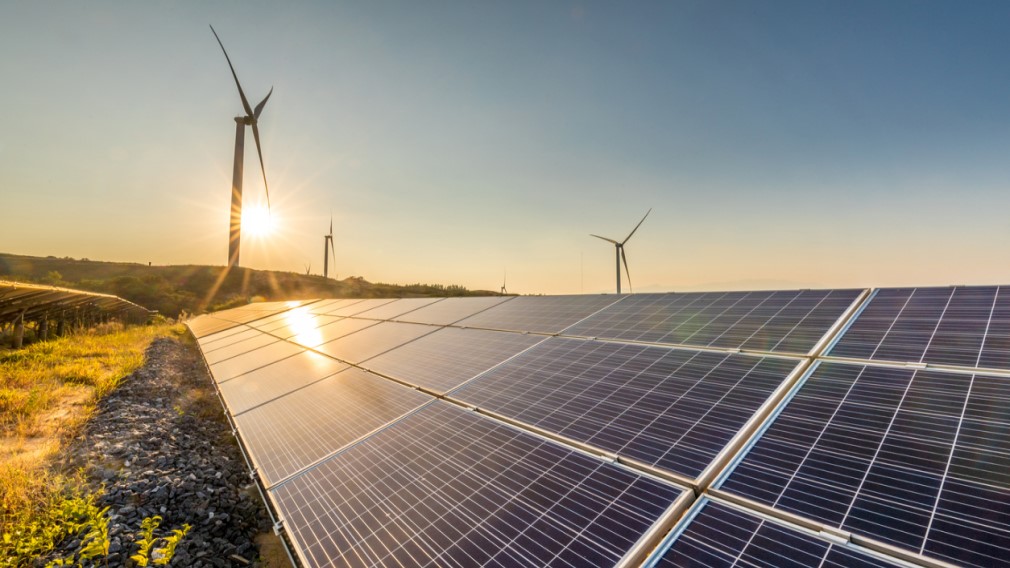Commodities Update September 2022
Our forecasts are based on 3 principles: 1. A bulks supply recovery as the industry faces Chinese peak steel; 2. Aggressive monetary policy suppressing growth in ‘23 then a recovery in ‘24; & 3. Resource sector underinvestment, particularly carbon-based energy & base metals including ‘green metals'

The following text is based on the article in the Septemeber Market Outlook (PDF 423KB)
For more details on our longer term forecasts see September Commodity Forecasts
Commodity prices continue to be very volatile with a significant dispersion in direction, as well as magnitude, of price changes through August. Our broad index is 6.2% higher in month since the last report but this masks a wide dispersion in outcomes. At the upper extreme is the 44% increase in met coal and a 12.3% lift in thermal coal contrasted to the 7.9% fall in iron ore. Crude oil (Brent) fell 5.9% in the month and yet LNG is up 11.7%. Our base metals index is down 3.4% but this is composed of a 6.5% fall in aluminium, a 7.5% fall in zinc and lead, a 1.7% fall in nickel and a 0.4% increase in copper. Gold fell 3.4% in the month while rural commodities rose 2.3%.
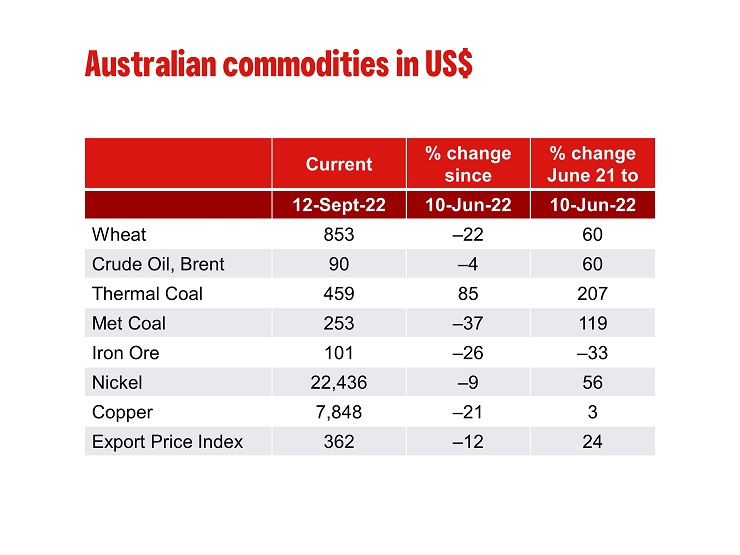
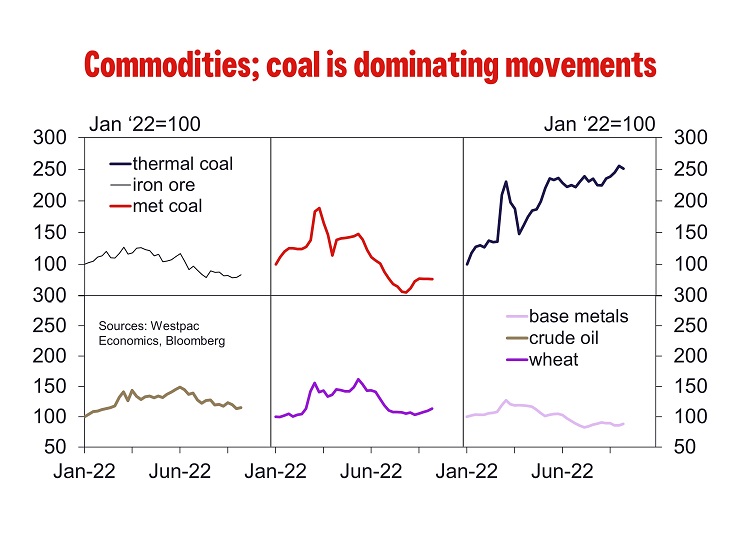
With this ongoing volatility in commodity prices we have focused on three key principles in formulating our forecasts.
- Bulks (iron ore and met coal) are set to face an ongoing recovery in supply just as the global steel industry faces restructuring associated with China having hit peak steel seeing iron ore and coal prices, both met and thermal, continuing to trend lower through 2024.
- The aggressive tightening of global monetary policy is set to slow US and European growth in 2023 to 0.6% and 1.5% respectively. While Chinese growth is set to lift to 7.0% in 2022, from 3.0% in 2023, and this will support global growth of 3.4% the moderation in developed world demand will act as a brake on energy and base metal prices until we get a recovery heading into 2024 fuelled by loosening in monetary policy and a weaker US dollar. The will see crude oil, LNG and base metals lover through 2023 before recovering through 2024.
- Underinvestment in the resources sector continues, particularly for carbon-based energy and base metals including ‘green metals’, resulting in a further tightening in supply as we head into 2024 and a recovery in developed world demand. This will be an inflationary influence for the broader commodity matrix from 2024 with particular focus on the base metals and carbon based energy.
Due to base effects, there is a stronger profile for our overall commodities index but due to the above factors there is significant variation not just in the magnitude of price changes but also the direction. Westpac’s Export Price Index is now 9.6% higher at end 2022 and 9.4% higher at end 2023. But the variation between the commodities has been significant. At US$100/t at end 2022 iron ore prices have been revised down 4.8% but remain at US$90/t for end 2023. Contrast that with 13.4% upward revision for met coal at end 2022 (to US$240/t) and a 21.4% upward revision to thermal coal (to US$425/t). The pressure on met coal is likely remain due to tight supply condition hence the 4.5% upward revision to the end 2023 forecast to US$212/t. Thermal coal is face a more uncertain time give extended elevated prices, the potential lift in Australian supply to more normal levels and the ongoing significant discounts for South African and Indonesian coal so we have revised down the end 2023 forecast by 14.3% to US$150/t.

Crude oil prices have fallen recently as demand fears outweighed continuing tight supply conditions; our end 2022 Brent forecast has been lowered 8% to US$92/bbl. The new low in crude is US$87bbl in March 2023. From there the recovery though 2024, a lower US dollar and a continuing tight supply will see Brent prices back to US$92/bbl, 8.2% higher than we had in the August report. We are not seeing the usual lift in US crude oil production at current price levels while Russian production is in decline as their industry struggles with maintenance and capital investment as western companies exit the country and trade embargos prevent the importation of critical equipment.

The recent weakness in crude oil prices has been due, in part, due to the market focusing on the growth risks associate with rising interest rates and the European energy crisis. However, the Atlantic hurricane season is nearing its halfway point and so far, no hurricanes have made landfall on the coast of the United States, contributing to the recent downward pressure on oil and fuel prices. The Atlantic season lasts from June 1 to November 30, with half of the storms usually occurring before September 12; U.S. National Oceanic and Atmospheric Administration (NOAA). On average, four hurricanes made landfall on the Atlantic or Gulf Coasts by September 12 between 1851 and 2021 (“Hurricane database”, HURDAT2, NOAA).
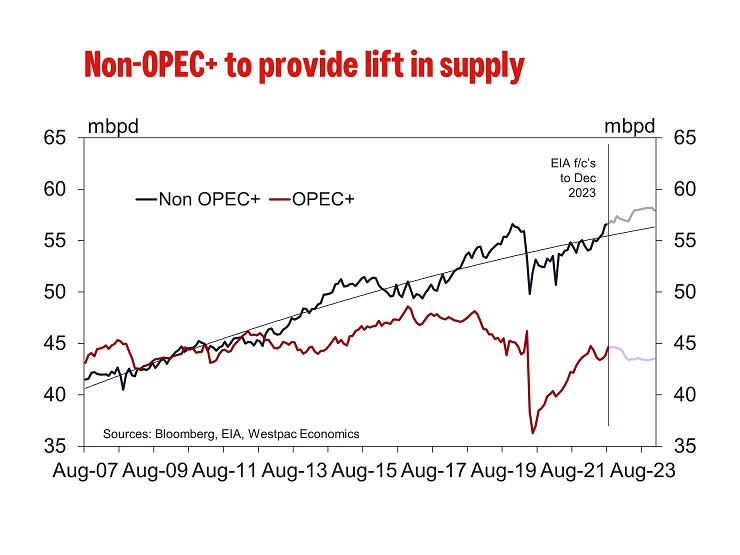
Through August EU natural gas prices spiked to a record high of US$70/mmbtu, more than treble the US$20/mmbtu for LNG landed in Japan and seven times the around US$10/mmbtu for US natural gas (Henry Hub). The loss of Russian gas has had a significant impact on EU gas prices and while the increase in demand for alternative sources has put upward pressure of global gas prices so far the moves in Asia and the US have been more mute than that in the EU; since June 2021 EU gas prices have surged 580% compared to a 172% increase in US natural gas and a smaller but still significant 110% increase in Japanese LNG. As the EU continues to tap into the global LNG market, and the US is the only likely possible supplier of additional LNG, then this has the potential to draw both the US and Japanese prices higher even without an increase in EU gas prices or even crude oil prices.

Investment in new oil supply hit a high of US$700 billion in 2014. But spending has been well below that level since. Over on the downstream processing side, global refining capacity declined in 2020 and 2021. For both oil producers and refiners, increasing net zero aspirations around the world have increase the uncertainty about future oil demand. This lack of investment is set hold the crude oil market in a very tight position which leave the market more prone to react to upside demand surprise than downside surprises.
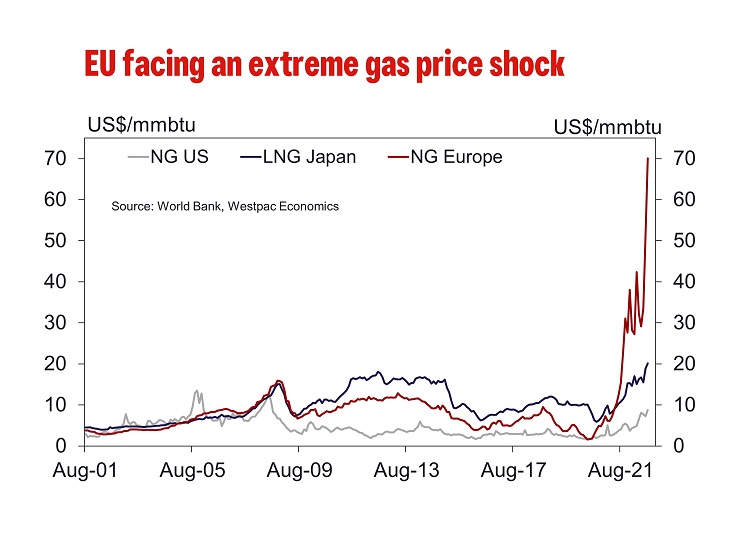
We expect to see a similar pattern in base metals with our Base Metals Index at end 2022 revised down 3.6% while the end 2023 forecast has been revised up 2.3%. However, for individual metals the outcomes are far more mix. Our end 2022 forecast for aluminium is down 10% (US$2,500/t), -8.5% for lead (US$2,050/t), -3.6% for nickel and just -1.3% for copper. In 2023 our year end forecasts for nickel are 6.1% higher (US$21,750/t), 5% higher for zinc (US$3,150) and 4.9% higher for copper (US$8,250) while our aluminium forecast was revised down -3.8% (US$2,600/t). As you can see in the chart below, since the market dislocation early this year nickel has maintained the relative a relative premium to the Base Metals Index since then.
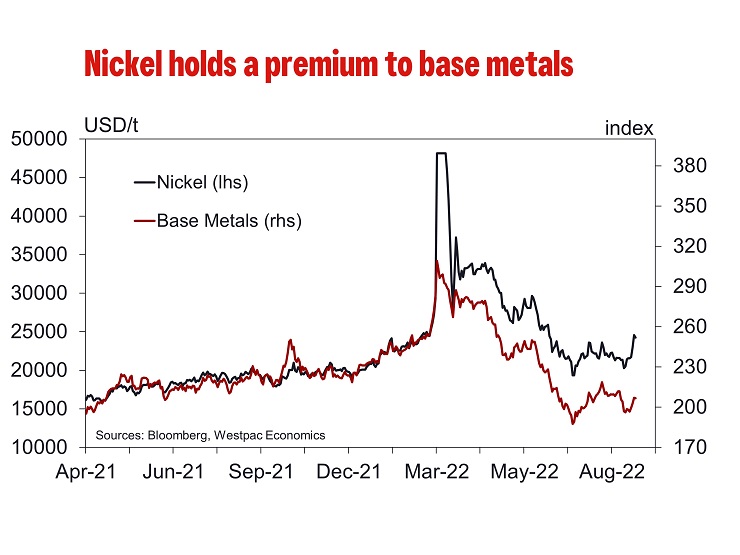
Our forecast for the rural/softs index for end 2022 has been revised down 3.6% but it was lifted 8.4% for end 2023.
Cost inflation (driven by the higher energy, labour, and other consumable prices) will be an ongoing challenge for the resources sector. For the Australian sector, iron ore and coal remain in a relatively better position compared to other commodities due to some offset from FX and very high margins on the cost of production. As such, some of this windfall gain will be recycled into repairs and short-term investments lifting production and smoothing out some of the supply chain disruptions lifting export volumes as we head in 2023. As such, with steel prices under pressure from falling sales and rising inventories this increase in volume will come just as demand remains anaemic putting further downward pressure on iron ore and met coal prices.

It is also worth highlighting just what a massive impact the EU demand for Australian coal, and tight supplies out of Australia due to very wet conditions on the east coast, have had on Australian thermal coal prices. At close to US$450/t Newcastle thermal coal is trading at a very unusual and very large premium to the higher grade and traditionally higher value met coal (around US$250/t). Even low vol PCI, which is lower grade met coal which normally trade between thermal and met coal, is now trading at a premium to premium low volatility met coal.

The premium for Australian coal is also significantly extended compared the low grade South African Coal (Richards Bay around US$250/t) and Indonesian coal (Kalimantan around US$125/t). Indonesia in particular is hampered by much lower grade of more polluting coal which is being shunned by the EU and their traditional markets of India and China now have access to cheaper, higher grade Russian coal that is facing embargos in many developed markets.

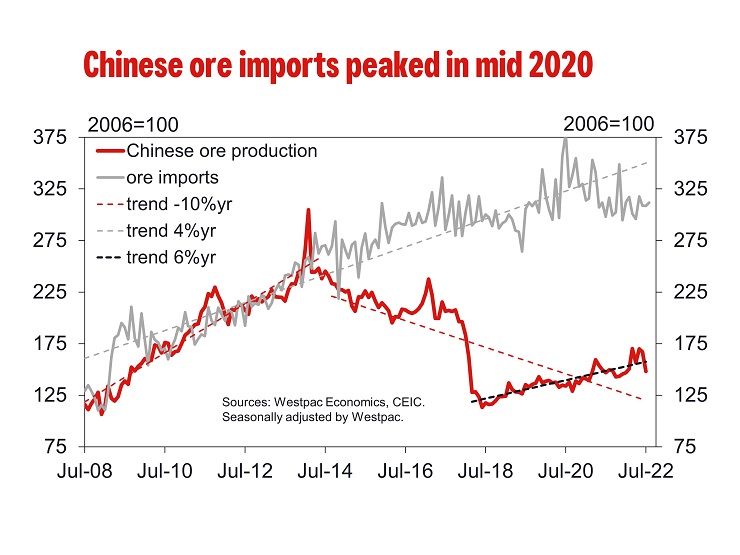
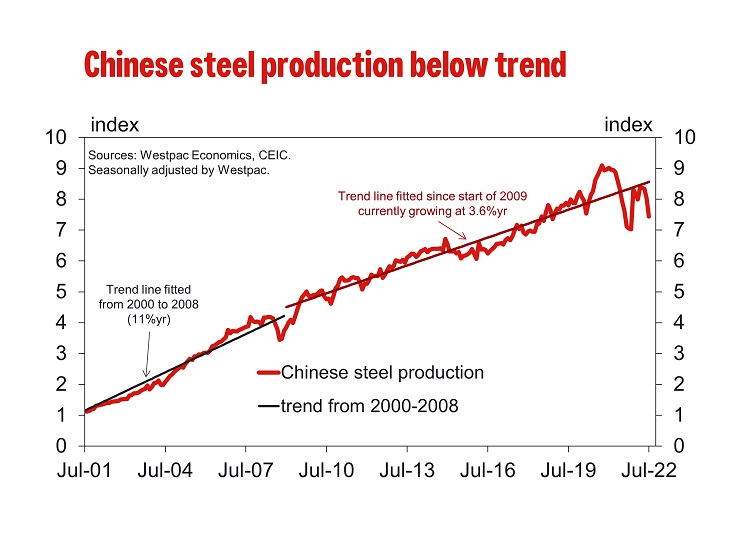


Stay informed with Westpac IQ
Get the latest reports straight to your inbox.
Browse topics
Disclaimer
©2025 Westpac Banking Corporation ABN 33 007 457 141 (including where acting under any of its Westpac, St George, Bank of Melbourne or BankSA brands, collectively, “Westpac”). References to the “Westpac Group” are to Westpac and its subsidiaries and includes the directors, employees and representatives of Westpac and its subsidiaries.
Things you should know
We respect your privacy: You can view the New Zealand Privacy Policy here, or the Australian Group Privacy Statement here. Each time someone visits our site, data is captured so that we can accurately evaluate the quality of our content and make improvements for you. We may at times use technology to capture data about you to help us to better understand you and your needs, including potentially for the purposes of assessing your individual reading habits and interests to allow us to provide suggestions regarding other reading material which may be suitable for you.
This information, unless specifically indicated otherwise, is under copyright of the Westpac Group. None of the material, nor its contents, nor any copy of it, may be altered in any way, transmitted to, copied of distributed to any other party without the prior written permission of the Westpac Group.
Disclaimer
This information has been prepared by Westpac and is intended for information purposes only. It is not intended to reflect any recommendation or financial advice and investment decisions should not be based on it. This information does not constitute an offer, a solicitation of an offer, or an inducement to subscribe for, purchase or sell any financial instrument or to enter into a legally binding contract. To the extent that this information contains any general advice, it has been prepared without taking into account your objectives, financial situation or needs and before acting on it you should consider the appropriateness of the advice. Certain types of transactions, including those involving futures, options and high yield securities give rise to substantial risk and are not suitable for all investors. We recommend that you seek your own independent legal or financial advice before proceeding with any investment decision.
This information may contain material provided by third parties. While such material is published with the necessary permission none of Westpac or its related entities accepts any responsibility for the accuracy or completeness of any such material. Although we have made every effort to ensure this information is free from error, none of Westpac or its related entities warrants the accuracy, adequacy or completeness of this information, or otherwise endorses it in any way. Except where contrary to law, Westpac Group intend by this notice to exclude liability for this information. This information is subject to change without notice and none of Westpac or its related entities is under any obligation to update this information or correct any inaccuracy which may become apparent at a later date. This information may contain or incorporate by reference forward-looking statements. The words “believe”, “anticipate”, “expect”, “intend”, “plan”, “predict”, “continue”, “assume”, “positioned”, “may”, “will”, “should”, “shall”, “risk” and other similar expressions that are predictions of or indicate future events and future trends identify forward-looking statements. These forward-looking statements include all matters that are not historical facts. Past performance is not a reliable indicator of future performance, nor are forecasts of future performance. Whilst every effort has been taken to ensure that the assumptions on which any forecasts are based are reasonable, the forecasts may be affected by incorrect assumptions or by known or unknown risks and uncertainties. The ultimate outcomes may differ substantially from any forecasts.
Conflicts of Interest: In the normal course of offering banking products and services to its clients, the Westpac Group may act in several capacities (including issuer, market maker, underwriter, distributor, swap counterparty and calculation agent) simultaneously with respect to a financial instrument, giving rise to potential conflicts of interest which may impact the performance of a financial instrument. The Westpac Group may at any time transact or hold a position (including hedging and trading positions) for its own account or the account of a client in any financial instrument which may impact the performance of that financial instrument.
Author(s) disclaimer and declaration: The author(s) confirms that (a) no part of his/her compensation was, is, or will be, directly or indirectly, related to any views or (if applicable) recommendations expressed in this material; (b) this material accurately reflects his/her personal views about the financial products, companies or issuers (if applicable) and is based on sources reasonably believed to be reliable and accurate; (c) to the best of the author’s knowledge, they are not in receipt of inside information and this material does not contain inside information; and (d) no other part of the Westpac Group has made any attempt to influence this material.
Further important information regarding sustainability-related content: This material may contain statements relating to environmental, social and governance (ESG) topics. These are subject to known and unknown risks, and there are significant uncertainties, limitations, risks and assumptions in the metrics, modelling, data, scenarios, reporting and analysis on which the statements rely. In particular, these areas are rapidly evolving and maturing, and there are variations in approaches and common standards and practice, as well as uncertainty around future related policy and legislation. Some material may include information derived from publicly available sources that have not been independently verified. No representation or warranty is made as to the accuracy, completeness or reliability of the information. There is a risk that the analysis, estimates, judgements, assumptions, views, models, scenarios or projections used may turn out to be incorrect. These risks may cause actual outcomes to differ materially from those expressed or implied. The ESG-related statements in this material do not constitute advice, nor are they guarantees or predictions of future performance, and Westpac gives no representation, warranty or assurance (including as to the quality, accuracy or completeness of the statements). You should seek your own independent advice.
Additional country disclosures:
Australia: Westpac holds an Australian Financial Services Licence (No. 233714). You can access Westpac’s Financial Services Guide here or request a copy from your Westpac point of contact. To the extent that this information contains any general advice, it has been prepared without taking into account your objectives, financial situation or needs and before acting on it you should consider the appropriateness of the advice.
New Zealand: In New Zealand, Westpac Institutional Bank refers to the brand under which products and services are provided by either Westpac (NZ division) or Westpac New Zealand Limited (company number 1763882), the New Zealand incorporated subsidiary of Westpac ("WNZL"). Any product or service made available by WNZL does not represent an offer from Westpac or any of its subsidiaries (other than WNZL). Neither Westpac nor its other subsidiaries guarantee or otherwise support the performance of WNZL in respect of any such product. WNZL is not an authorised deposit-taking institution for the purposes of Australian prudential standards. The current disclosure statements for the New Zealand branch of Westpac and WNZL can be obtained at the internet address www.westpac.co.nz.
Singapore: This material has been prepared and issued for distribution in Singapore to institutional investors, accredited investors and expert investors (as defined in the applicable Singapore laws and regulations) only. Recipients of this material in Singapore should contact Westpac Singapore Branch in respect of any matters arising from, or in connection with, this material. Westpac Singapore Branch holds a wholesale banking licence and is subject to supervision by the Monetary Authority of Singapore.
Fiji: Unless otherwise specified, the products and services for Westpac Fiji are available from www.westpac.com.fj © Westpac Banking Corporation ABN 33 007 457 141. This information does not take your personal circumstances into account and before acting on it you should consider the appropriateness of the information for your financial situation. Westpac Banking Corporation ABN 33 007 457 141 is incorporated in NSW Australia and registered as a branch in Fiji. The liability of its members is limited.
Papua New Guinea: Unless otherwise specified, the products and services for Westpac PNG are available from www.westpac.com.pg © Westpac Banking Corporation ABN 33 007 457 141. This information does not take your personal circumstances into account and before acting on it you should consider the appropriateness of the information for your financial situation. Westpac Banking Corporation ABN 33 007 457 141 is incorporated in NSW Australia. Westpac is represented in Papua New Guinea by Westpac Bank - PNG - Limited. The liability of its members is limited.
U.S.: Westpac operates in the United States of America as a federally licensed branch, regulated by the Office of the Comptroller of the Currency. Westpac is also registered with the US Commodity Futures Trading Commission (“CFTC”) as a Swap Dealer, but is neither registered as, or affiliated with, a Futures Commission Merchant registered with the US CFTC. The services and products referenced above are not insured by the Federal Deposit Insurance Corporation (“FDIC”). Westpac Capital Markets, LLC (‘WCM’), a wholly-owned subsidiary of Westpac, is a broker-dealer registered under the U.S. Securities Exchange Act of 1934 (‘the Exchange Act’) and member of the Financial Industry Regulatory Authority (‘FINRA’). In accordance with APRA's Prudential Standard 222 'Association with Related Entities', Westpac does not stand behind WCM other than as provided for in certain legal agreements between Westpac and WCM and obligations of WCM do not represent liabilities of Westpac.
This communication is provided for distribution to U.S. institutional investors in reliance on the exemption from registration provided by Rule 15a-6 under the Exchange Act and is not subject to all of the independence and disclosure standards applicable to debt research reports prepared for retail investors in the United States. WCM is the U.S. distributor of this communication and accepts responsibility for the contents of this communication. Transactions by U.S. customers of any securities referenced herein should be effected through WCM. All disclaimers set out with respect to Westpac apply equally to WCM. If you would like to speak to someone regarding any security mentioned herein, please contact WCM on +1 212 389 1269. Investing in any non-U.S. securities or related financial instruments mentioned in this communication may present certain risks. The securities of non-U.S. issuers may not be registered with, or be subject to the regulations of, the SEC in the United States. Information on such non-U.S. securities or related financial instruments may be limited. Non-U.S. companies may not be subject to audit and reporting standards and regulatory requirements comparable to those in effect in the United States. The value of any investment or income from any securities or related derivative instruments denominated in a currency other than U.S. dollars is subject to exchange rate fluctuations that may have a positive or adverse effect on the value of or income from such securities or related derivative instruments.
The author of this communication is employed by Westpac and is not registered or qualified as a research analyst, representative, or associated person of WCM or any other U.S. broker-dealer under the rules of FINRA, any other U.S. self-regulatory organisation, or the laws, rules or regulations of any State. Unless otherwise specifically stated, the views expressed herein are solely those of the author and may differ from the information, views or analysis expressed by Westpac and/or its affiliates.
UK: The London branch of Westpac is authorised in the United Kingdom by the Prudential Regulation Authority (PRA) and is subject to regulation by the Financial Conduct Authority (FCA) and limited regulation by the PRA (Financial Services Register number: 124586). The London branch of Westpac is registered at Companies House as a branch established in the United Kingdom (Branch No. BR000106). Details about the extent of the regulation of Westpac’s London branch by the PRA are available from us on request.
This communication is not being made to or distributed to, and must not be passed on to, the general public in the United Kingdom. Rather, this communication is being made only to and is directed at (a) those persons falling within the definition of Investment Professionals (set out in Article 19(5) of the Financial Services and Markets Act 2000 (Financial Promotion) Order 2005 (the “Order”)); (b) those persons falling within the definition of high net worth companies, unincorporated associations etc. (set out in Article 49(2)of the Order; (c) other persons to whom it may lawfully be communicated in accordance with the Order or (d) any persons to whom it may otherwise lawfully be made (all such persons together being referred to as “relevant persons”). Any person who is not a relevant person should not act or rely on this communication or any of its contents. In the same way, the information contained in this communication is intended for “eligible counterparties” and “professional clients” as defined by the rules of the Financial Conduct Authority and is not intended for “retail clients”. Westpac expressly prohibits you from passing on the information in this communication to any third party.
European Economic Area (“EEA”): This material may be distributed to you by either: (i) Westpac directly, or (ii) Westpac Europe GmbH (“WEG”) under a sub-licensing arrangement. WEG has not edited or otherwise modified the content of this material. WEG is authorised in Germany by the Federal Financial Supervision Authority (‘BaFin’) and subject to its regulation. WEG’s supervisory authorities are BaFin and the German Federal Bank (‘Deutsche Bundesbank’). WEG is registered with the commercial register (‘Handelsregister’) of the local court of Frankfurt am Main under registration number HRB 118483. In accordance with APRA’s Prudential Standard 222 ‘Association with Related Entities’, Westpac does not stand behind WEG other than as provided for in certain legal agreements (a risk transfer, sub-participation and collateral agreement) between Westpac and WEG and obligations of WEG do not represent liabilities of Westpac. Any product or service made available by WEG does not represent an offer from Westpac or any of its subsidiaries (other than WEG). All disclaimers set out with respect to Westpac apply equally to WEG.
This communication is not intended for distribution to, or use by any person or entity in any jurisdiction or country where such distribution or use would be contrary to local law or regulation.
This communication contains general commentary, research, and market colour. The communication does not constitute investment advice. The material may contain an ‘investment recommendation’ and/or ‘information recommending or suggesting an investment’, both as defined in Regulation (EU) No 596/2014 (including as applicable in the United Kingdom) (“MAR”). In accordance with the relevant provisions of MAR, reasonable care has been taken to ensure that the material has been objectively presented and that interests or conflicts of interest of the sender concerning the financial instruments to which that information relates have been disclosed.
Investment recommendations must be read alongside the specific disclosure which accompanies them and the general disclosure which can be found here. Such disclosure fulfils certain additional information requirements of MAR and associated delegated legislation and by accepting this communication you acknowledge that you are aware of the existence of such additional disclosure and its contents.
To the extent this communication comprises an investment recommendation it is classified as non-independent research. It has not been prepared in accordance with legal requirements designed to promote the independence of investment research and therefore constitutes a marketing communication. Further, this communication is not subject to any prohibition on dealing ahead of the dissemination of investment research.

